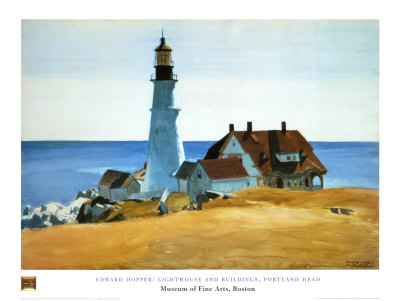The American painter Edward Hopper and his wife, fellow artist Josephine Nivison would often spend their summers in Cape Cod.
Hopper quickly became enamoured with the landscapes and scenery of the coastal region where they spent these holidays, and also developed a fascination with the lighthouses in the area and went on to paint several images of them in his work.
One of the most well-known and often reproduced of these is his watercolour of Lighthouse Porthead, depicting the Portland Head Lighthouse in Maine, which is still standing and operating today.
In this painting of Lighthouse Porthead, we see the lighthouse to the left of the lighthouse keeper's garage and house resting on the shore, at the edge of a golden-brown landscape.
Behind the structures, the vivid blue water and pale sky perfectly enhance the buildings, bringing them immediately to the forefront of the painting.
Perhaps what Edward Hopper is best known for is for his many realistic depictions of life in America from the Great Depression to the middle of the century. The profound loneliness, alienation, and activities taking place in the lives of common people seem to be captured in a snapshot of realism within each Edward Hopper painting.
With his depictions of lighthouses, that sense of solitude and loneliness is still present, with the lighthouse being commonly regarded as a symbol for loneliness.
Another common motif in Hopper's work is his use of light and shadow. Prime examples of his studies in light are People in the Sun, Sun in an Empty Room, and Sunlight on Brownstones, among many others.
It seems fitting, then, that he would become so taken with the symbol of the lighthouse, a solitary object in the dark, intermittently shining out a beam of light to those lost in the shadows.
Of his many lighthouse paintings, his wife Josephine remarked after his passing in 1967 that his lighthouse paintings were actually self-portraits.




